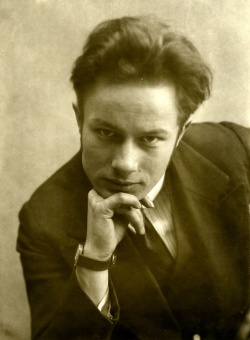Difference between revisions of "Nikolaus Braun"
(Created page with "Nikolaus Braun (Miklos Bela). Born 1900. German/Hungarian artist and sculptor. In 1920 he became a student of Arthur Segal at his painting studio in Berlin. Segal and Braun w...") |
|||
| Line 1: | Line 1: | ||
| − | Nikolaus Braun ( | + | {{Infobox artist |
| + | |image = Nikolaus_Braun_1920.jpg | ||
| + | |imagesize = 250px | ||
| + | |caption = Nikolaus Braun in 1920. | ||
| + | |birth_date = {{birth date|1900|1|17|mf=y}} | ||
| + | |birth_place = Berlin | ||
| + | |death_date = 1950 | ||
| + | |death_place = New York City | ||
| + | }} | ||
| + | '''Nikolaus Braun''' (Miklós Bela) was a German/Hungarian artist and sculptor, born 1900 in Berlin. He studied under [[Arthur Segal]] at the Kunstschule in Berlin and joined the [[Novembergruppe]], a loose union of radical artists, which was created in December 1918 in Berlin under the impression of the November revolution. Braun exhibited with the group from 1923 on. In the mid-1920s, Braun and Segal worked with light and its effect, producing photos and light reliefs, which were anticipating kinetic art. In 1925, Braun published the essay "Konkretes Licht" in the book ''Licht Probleme in der bildenden Kunst''. Both, Segal and Braun were also associated with [[Der Sturm]] and the [[December Gallery]]. [http://weimarart.blogspot.com/2010/06/nikolaus-braun.html] [http://access.cjh.org/home.php?type=extid&term=1027636#1] | ||
| − | In 1924, Braun participated in the [[First German Art Exhibition]] in Moscow. In 1925, Braun and Segal published a treatise entitled ''Lichtprobleme der Bildenden Kunst'' (On the Problem of Light in the Fine Arts). This volume was an exploration of the meaning of light and form in their work. This book is extremely rare and only four copies are known to be in libraries worldwide. Both, teacher and student were strongly influenced by [[Viking Eggeling]]’s early film experiments. In 1924, Braun and Segal, along with [[Laszlo Moholy-Nagy]], [[Laszlo Peri]], [[Erno Kallai]] and [[Alfred Kemeny]] were in attendance at Eggeling’s presentation of the Diagonal Symphony. | + | In 1924, Braun participated in the [[First German Art Exhibition]] in Moscow. In 1925, Braun and Segal published a treatise entitled ''Lichtprobleme der Bildenden Kunst'' (On the Problem of Light in the Fine Arts). This volume was an exploration of the meaning of light and form in their work. This book is extremely rare and only four copies are known to be in libraries worldwide. Both, teacher and student were strongly influenced by [[Viking Eggeling]]’s early film experiments. In 1924, Braun and Segal, along with [[Laszlo Moholy-Nagy]], [[Laszlo Peri]], [[Erno Kallai]] and [[Alfred Kemeny]] were in attendance at Eggeling’s presentation of the ''Diagonal Symphony''. [http://weimarart.blogspot.com/2010/06/nikolaus-braun.html] |
| + | 1920-1938, Nikolaus Braun was married to the painter Anne Ratkowski (born 1903 in Berlin) [http://digifindingaids.cjh.org/?pID=481396]. In 1938, he and Anne Ratkowski destroyed their paintings before escaping Nazi Germany to Belgium. The same year, Braun moved on to Hungary, where he lived during World War II. 1949 he immigrated to the United States, where he died one year later in New York City. [http://access.cjh.org/home.php?type=extid&term=1027636#1] | ||
| − | http:// | + | ; Correspondence |
| + | * [http://www.archive.org/stream/anneratkowskiwanf002#page/n0/mode/1up Letters from Arthur Segal to Nikolaus Braun and Anneliese Ratkowski], 1920-29. | ||
| + | * [http://www.archive.org/stream/anneratkowskiwanf003#page/n0/mode/1up Letters from Arthur Segal to Nikolaus Braun and Anneliese Ratkowski], 1930-35. | ||
| + | * [http://www.archive.org/stream/anneratkowskiwanf004#page/n0/mode/1up Letters from Arthur Segal to Nikolaus Braun and Anneliese Ratkowski], 1936-39. | ||
| + | |||
| + | ; See also | ||
| + | * [[Arthur Segal]] | ||
Revision as of 23:51, 24 January 2014
 Nikolaus Braun in 1920. | |
| Born |
January 17, 1900 Berlin |
|---|---|
| Died |
1950 New York City |
Nikolaus Braun (Miklós Bela) was a German/Hungarian artist and sculptor, born 1900 in Berlin. He studied under Arthur Segal at the Kunstschule in Berlin and joined the Novembergruppe, a loose union of radical artists, which was created in December 1918 in Berlin under the impression of the November revolution. Braun exhibited with the group from 1923 on. In the mid-1920s, Braun and Segal worked with light and its effect, producing photos and light reliefs, which were anticipating kinetic art. In 1925, Braun published the essay "Konkretes Licht" in the book Licht Probleme in der bildenden Kunst. Both, Segal and Braun were also associated with Der Sturm and the December Gallery. [1] [2]
In 1924, Braun participated in the First German Art Exhibition in Moscow. In 1925, Braun and Segal published a treatise entitled Lichtprobleme der Bildenden Kunst (On the Problem of Light in the Fine Arts). This volume was an exploration of the meaning of light and form in their work. This book is extremely rare and only four copies are known to be in libraries worldwide. Both, teacher and student were strongly influenced by Viking Eggeling’s early film experiments. In 1924, Braun and Segal, along with Laszlo Moholy-Nagy, Laszlo Peri, Erno Kallai and Alfred Kemeny were in attendance at Eggeling’s presentation of the Diagonal Symphony. [3]
1920-1938, Nikolaus Braun was married to the painter Anne Ratkowski (born 1903 in Berlin) [4]. In 1938, he and Anne Ratkowski destroyed their paintings before escaping Nazi Germany to Belgium. The same year, Braun moved on to Hungary, where he lived during World War II. 1949 he immigrated to the United States, where he died one year later in New York City. [5]
- Correspondence
- Letters from Arthur Segal to Nikolaus Braun and Anneliese Ratkowski, 1920-29.
- Letters from Arthur Segal to Nikolaus Braun and Anneliese Ratkowski, 1930-35.
- Letters from Arthur Segal to Nikolaus Braun and Anneliese Ratkowski, 1936-39.
- See also